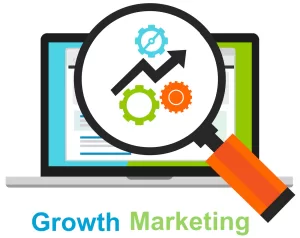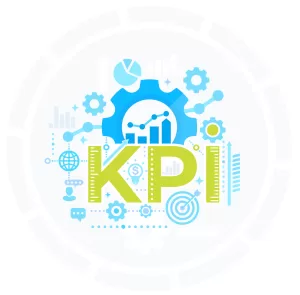 Growth marketing isn’t a new buzzword or some alternate term for digital marketing. Even though there are some similarities and overlap between the two, they are not the same. Both have a different approach with different perspectives.
Growth marketing isn’t a new buzzword or some alternate term for digital marketing. Even though there are some similarities and overlap between the two, they are not the same. Both have a different approach with different perspectives.
Digital marketing typically focuses on creating awareness and driving sales using ‘top of funnel’ strategies. However, growth marketing takes a more holistic approach to driving growth and revenue throughout the entire marketing funnel.
On its own, digital marketing can be great for getting your name out there and driving traffic to your website, but not so much for achieving sustainable growth over the long term. That’s where growth marketing comes in to play. By focusing on customer acquisition, retention, and referral it can drive steady sustainable growth and success that lasts.
“At its core, it’s a process of research, experimentation, iteration, and testing. It uses data analysis to find the most effective tactics. These tactics are then scaled to drive rapid growth and to meet specific objectives.”
Instead of relying on established tactics and channels like digital marketing, growth marketing prioritizes experimentation and continuous refinement. This might involve testing new ad formats, new channels, trying different targeting options, or experimenting with new content formats and messaging strategies.
It’s a strategy that is a completely data-driven approach that methodically analyzes results to identify the most effective strategies for growth. This entire process is iterative and involves constant testing, learning, and optimization. It’s essential to creating sustainable, long-term growth machines for the business.
The Growth Marketing Process

The growth process involves several key phases that work together to achieve sustainable growth for your business. From understanding your target audience to optimizing your campaigns, each step is important for success. We’ll go through each phase of the process and provide a brief explanation.
The Research Phase: This includes gathering data, conducting research, analyzing customer behaviour, user preferences, and identifying opportunities for growth.
The goal of the research phase is to gain a deep understanding of the target audience and market landscape. This will help to inform the development of a targeted and effective growth plan.
Ideation Phase: Ideation is about brainstorming and generating creative ideas for growth strategies. It follows the research phase, and uses the insights gathered to develop unique, innovative ideas to acquiring and retaining customers. Furthermore it works to improve the customer experience, and increase revenue.
The ideation phase may involve techniques such as brainstorming sessions and prototyping to test and refine ideas before moving forward with the next phase.
Experimentation: This phase involves designing and executing controlled growth experiments. The process will validate the effectiveness of various growth strategies and tactics.
On top of that, by measuring performance metrics like conversion rates, customer acquisition costs, and customer lifetime value, the most effective approaches can be identified. These approaches are then refined over time for maximum impact.
Integration Phase: Here is where the validated experiments are integrated into the overall business strategy. By following a well developed, detailed growth blueprint these experiments are put into action.
This process involves deciding repetition, frequency and budgets against ROI as well as using technology to scale parts of the process that can be automated.
Performance and progress is closely monitored, and adjustments are made as necessary to ensure that growth continues. This could include revising campaigns, developing new content, adding new channels or new team members.
Another key aspect is establishing communication channels between the growth team and other departments, such as marketing, product development, sales, and customer service.
By working closely with these teams, growth specialists can ensure that their efforts are aligned with product roadmaps, sales targets, and customer support goals.
Incorporating growth tactics with digital marketing strategies can have a huge impact on key metrics

As you’ve most likely already gathered from reading this post, growth marketing can have a HUGE impact on key metrics for your business.
Through prioritizing customer satisfaction and loyalty, growth strategies help to increase CLV (Customer Lifetime Value) encouraging repeat purchases, cross-selling, upselling etc. This can ultimately lead to increased revenue per customer and a higher overall CLV.
Growth strategies & tactics can lower CAC (Customer Acquisition Costs) through optimization of ad spend and targeting the right audience at the right time with the right message. Experimenting with different messaging strategies and content formats can increase engagement and drive qualified leads, reducing the overall cost of customer acquisition.
Business are always looking for more positive impact on return on ad spend (ROAS). You’ll see maximum results with a more data-driven approach to marketing that leverages insights and analytics to optimize campaigns.
Different messaging, channels, strategies, ad formats etc. can help you identify the most effective channels and messaging to reach your target audience, driving more engagement and conversions.
Growth marketing’s long-term approach focuses on sustainable growth to improve overall ROI (Return on Investment). It works to build a strong brand, increase customer loyalty and providing optimum returns on ad spend to increase revenue and profitability.
“Without a strategic approach to growth, your digital marketing efforts won’t be optimized for long-term success and could lead to stagnation or decline.”
If you’re not incorporating growth strategies into your digital marketing efforts, you may be missing out on valuable opportunities to maximize your business’s potential for growth and revenue. Without a strategic approach to digital marketing, your efforts may not be optimized for long-term success and could lead to stagnation or decline in your business.
By implementing growth strategies such as customer engagement, ongoing analytics and optimization, and data-driven decision making, you can ensure that your digital marketing efforts are contributing to sustainable long-term growth and success for your business.
Ready to achieve sustainable growth for your business?
Schedule a call with us today to get started!
